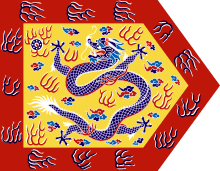This article is about the Manchurian military unit. For the place bearing the same Chinese name, see
Xianghuang Banner.
The Bordered Yellow Banner was one of the Eight Banners of the Manchu Qing dynasty military. The Bordered Yellow Banner was one of three "upper" banner armies under the direct command of the emperor himself, and one of the four "left wing" banners.
The Plain Yellow Banner and the Bordered Yellow Banner were split from each other in 1615, when the troops of the original four banner armies (Yellow, Blue, Red, and White) were divided into eight by adding a bordered variant to each banner's design., and originally commanded personally by Nurhaci. After Nurhaci's death, his son Hong Taiji became khan, and took control of both yellow banners. Later, the Shunzhi Emperor took over the Plain White Banner after the death of his regent, Dorgon, to whom it previously belonged. From that point forward, the emperor directly controlled three "upper" banners (Plain Yellow, Bordered Yellow, and Plain White), as opposed to the other five "lower" banners. Because of the direct control of the three upper banners, there was no appointed banner commanders as opposed to the other five. The emperor's personal guards and guards of Forbidden City were also only selected from the upper three banners.[5]
Further reading
- Dennerline, Jerry (2002), "The Shun-Chih Reign", in Peterson, Willard J.; Twitchett, Denis Crispin; Fairbank, John King, The Cambridge History of China: Volume 9, Part 1, The Ch'ing Empire to 1800, The Cambridge History of China, 9, Cambridge University Press, ISBN 9780521243346
